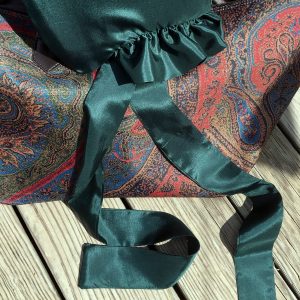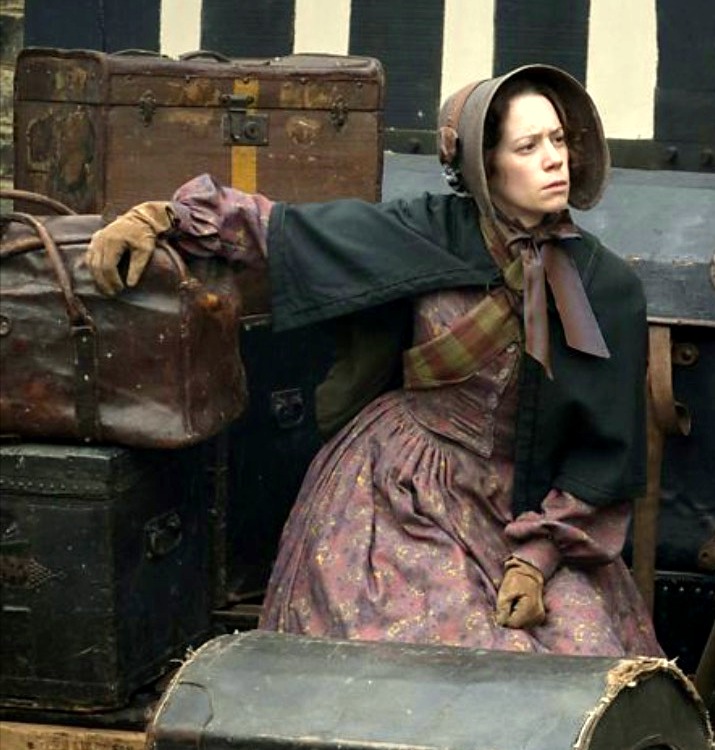The Travel Wardrobe
 When Kerstin and I started Augusta’s Journey, we decided that in order to get into character of a wealthy 1840s girl (or to be honest, her mother), we should construct garments based on historical records and wear them when we follow in Augusta’s footsteps. We would need a travel wardrobe!
When Kerstin and I started Augusta’s Journey, we decided that in order to get into character of a wealthy 1840s girl (or to be honest, her mother), we should construct garments based on historical records and wear them when we follow in Augusta’s footsteps. We would need a travel wardrobe!
For our first leg of this journey, the cruise on Göta Canal, we made 3 different dresses each, and bonnets to match. And of course we also made petticoats, corsets, hat boxes, carpet bags, and parasols.
In a couple of weeks, we are embarking on our German journey, and we realized that this would necessitate new outfits suitable for traveling by train and hiking in national parks. And as Augusta visited the opera in both Berlin and Dresden, we would also have to make ball gowns suitable for going to the opera.
The fall dresses should be in fine wool and dark, fall colors. Kerstin soon found beautiful fabrics in Sweden and sent me pictures. I found nothing in Lincoln, because as Joanne Fabrics told me “we don’t stock any wool or silk fabrics”. So I scoured the local thrift stores for large pieces of clothing with a fabric label of 100% wool. The first one I found was a dark green women’s suit jacket for $1. That would make a fantastic pelerine. And then I also found 3 yards of checkered orange and green cotton for $5. What I had in mind was something like the outfit of Emilie Bronte in BBCs series To Walk Invisible: The Bronte Sisters. The Bronte sisters were contemporary with Augusta and the similarities between their world and Augusta’s warrants a blog entry just by itself.
Anyway, I cut up the jacket. The wool fabric was just enough for the pelerine after I had done some little patchwork of pieces. The lining of the jacket was also just enough for making a matching bonnet. The checkered fabric would not be enough for a full dress, which usually requires 5 yards. But it would be enough for one with short sleeves and not quite as wide a skirt. In the end, I was satisfied with the outfit. The only problem I foresee is having short sleeves in October! Maybe I can find a thin cardigan to wear over it.
Having made one outfit, I realized that I would need to make two more – I would have to resort to ordering fabric online. A heavy package containing 5 meters of brown, twill wool fabric arrived last week. That would be enough for one dress. I would still need to figure out one more dress or skirt.
In the meanwhile, I started on the ball gown. First you need to figure out the pattern – then make a test dress in cheap cotton – and then, finally make the gown in silk. Figuring out the pattern took several days – I actually used sturdy paper towel that I could stitch together and try. The benefit was that I didn’t have to buy special paper and I could then reuse the paper towel pieces in the kitchen. I then purchased $2.97/yard clearance cotton fabric from Walmart and made a prototype ball gown. That took another week. Will I ever use this one?
And last Friday, I started on my silk fabric that I bought last fall in the Gold Souk area of Deira, Dubai. It is ox blood color and will have black lace. I am hoping to finish it this week so I can make my wool dresses.
So what I have I learned?
- The best places for cheap fabric, lace, and spools of thread are thrift stores or charity shops. And the best place for safety pins are dollar stores.
- Paper towel is great for making and testing patterns – you could sew a whole outfit just of paper towel!
- Zip ties or duct tie straps make good substitutes for whale bone, and buckram is also a very useful material for clothing construction.
- Hand sewing takes less time than one thinks, and you make fewer mistakes than when you use a sewing machine. Undoing mistakes take a lot of time and is frustrating.
- Making bias tape is quicker than going around trying to find bias tape of the right color.
Finally, and most importantly (at least to my husband)
- It is easier to find pins on the floor if they have the colorful heads.


